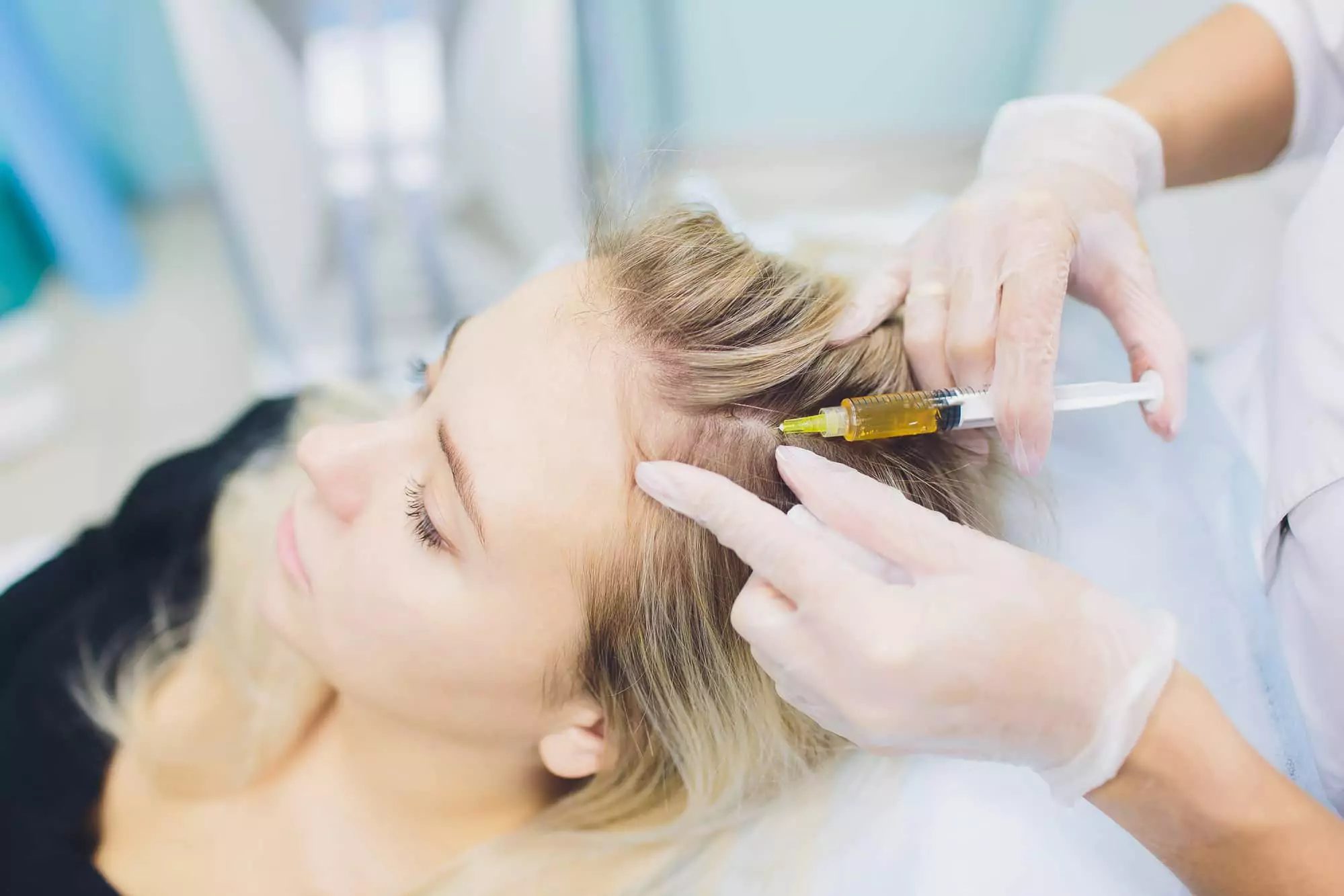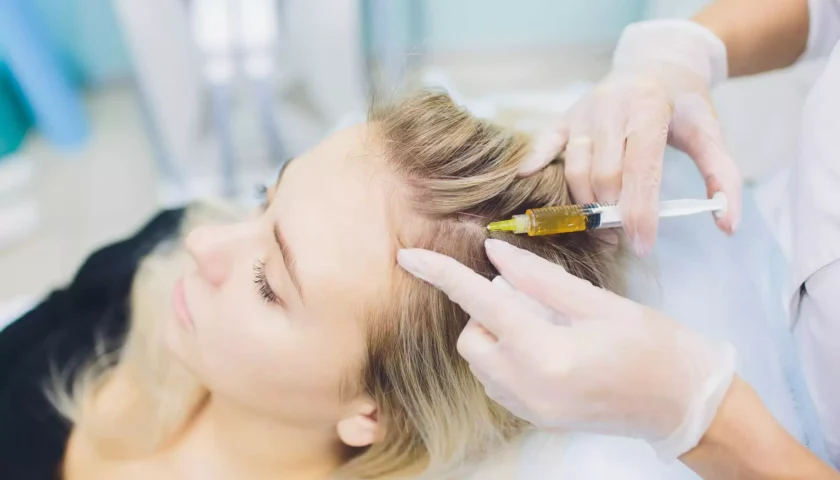
Gorgeous hair is not a fashion or a passing trend but an all-time beauty standard. It is not only facial features that make a person beautiful but also healthy, well-groomed locks. Shiny, flowing locks are an integral part of a chic image.
The natural beauty of hair is lost under the influence of such factors as:
- Weather conditions;
- Hair styling products;
- Numerous hair coloring;
- Lack of vitamins;
- Stresses;
- Unhealthy lifestyle.
It used to seem difficult, if not impossible, to restore our hair to its former health and stop it from falling out. Striving for perfection and restoring hair to its former glory. Home care did not bring the desired result, and specialist beauty salons shrugged.
But now, with hair fillers, restoring scalp health and stopping hair loss is possible.
What Is a Hair Filler?
Hair fillers are injectable treatments that add volume and stimulate hair growth in areas with thinning or sparse hair. They are a cosmetic solution for hair loss. They can also be used to enhance the hairline’s appearance or fill areas where hair has been lost due to scarring or injury. Hair fillers are temporary and usually last for several months to a year.
In addition, there are cosmetic products with a similar name – hair filler powders. These products claim to add volume and thickness to hair. They are typically made of microfibers or keratin fibers that adhere to hair strands to create the illusion of thicker hair.
Hair filler powders come in various colors to match different hair shades and can be applied directly to the scalp or hair using a brush or applicator. They are often marketed as a quick and easy solution for thinning hair or bald spots. It’s important to note that it’s just a temporary cosmetic fix that does not treat the underlying causes of hair loss.
Content of Hair Filler
The content of hair fillers can vary depending on the specific product used. However, common materials used in hair fillers include:
- Hyaluronic acid: This is a natural body substance that helps to retain moisture and promote cell growth. When used in hair fillers, it can stimulate hair growth and add volume to the scalp.
- Collagen: This is a protein found in the body that gives skin its elasticity and strength. When used in hair fillers, it can improve the texture and thickness of the hair.
- Bioactive peptides: These are small chains of amino acids that can stimulate cell growth and collagen production. When used in hair fillers, they can improve hair growth and overall scalp and hair health.
Other ingredients that may be included in hair fillers include vitamins, minerals, and antioxidants, which can nourish the scalp and promote healthy hair growth. However, it’s important to note that the specific ingredients used in a hair filler will depend on the brand and product chosen.
How to Choose the Right Hair Filler
Choosing suitable hair filler products depends on several factors, including the severity of hair loss, the underlying cause, and personal preferences. Things to consider when choosing a hair filler:
- Consult with a dermatologist or hair restoration specialist: Before choosing a hair filler, it’s important to consult with a healthcare professional in hair loss and restoration. They can help you determine the underlying cause of your hair loss and recommend the best treatment options for your specific needs.
- Consider the type of filler: There are several types of hair fillers available, including hyaluronic acid, collagen, and bioactive peptides. Each type of filler has unique properties and benefits, so it’s essential to choose one best suited for your hair loss needs.
- Look for a reputable brand: Choose a hair filler from a reputable brand known for creating high-quality products. Look for brands with a good reputation and backed by scientific research.
- Read product reviews: Before choosing a hair filler, read reviews and testimonies from other customers who have used the product. It can give an idea of the product’s effectiveness and any potential side effects.
- Consider the cost: Hair fillers can vary in price, so choosing one within your budget is essential. It’s also important to note that the most expensive product isn’t always the best option.
Overall, choosing the suitable hair filler requires careful consideration and consultation with a healthcare professional.
The Hair Filler Procedure
Prepared hair fillers are injected under the skin with a syringe with very fine needles. It allows doctors to deliver the medication in the most precise way.
The procedure can be performed manually or with a device. The depth of injections is usually 2-4 mm. First, the skin is pre-treated with an antiseptic. Then injections are made at predetermined points, moving along the hair growth line and along the strike.
Before the injection, the skin is slightly stretched. After that, it is treated with antiseptic. The procedure lasts from 30 minutes to an hour.
As a rule, the hair fillers mesotherapy treatment course comprises 7 to 10 procedures. Therefore, they should be carried out not more often than once every ten days. Then you can go through the consolidation course. It may include from 4 to 6 procedures. Each is carried out approximately once a month.
Advantages of Hair Fillers
Hair fillers offer numerous benefits, such as:
- Supplying the hair with all the beneficial substances;
- Hair structure regeneration;
- Hair loss prevention;
- Protection from external factors;
- Making hair manageable;
- Effective treatment of split ends;
- Immediate results.
Preparation and Aftercare
Despite the procedure’s safety, hair filler mesotherapy has several contraindications. For example, pregnancy or scalp diseases. However, these are not the only ones. Unfortunately, there are quite a few contraindications. That is why it is crucial to consult a doctor and only then make a decision.
About a week before the mesotherapy, it is necessary to begin preparing for the appointment. As a rule, doctors recommend refraining from sunbathing, visiting the sauna, and taking certain medications or alcohol.
In addition, it is recommended to stop using styling products temporarily. Doing mesotherapy immediately after bleaching hair or a perm is not advised; at least 2–3 weeks should pass.
Finally, after hair filler treatment, you must not wash your hair for two days. It is also better to avoid visiting bathhouses, swimming pools, or saunas. A couple of days after the procedure, it is normal to feel a slight scalp burning. It may be accompanied by redness. Mild bruising on the injection site may persist for a week.
Fortunately, a dermal filler for hair gives fast, visible results. After a few days, if there are no complications, you can return to your usual hair care.
Conclusion
A course of mesotherapy with hair fillers revitalizes the hair, making it dense and soft, more voluminous, and giving it shine and radiance. Thanks to nourishing the scalp and hair follicles with essential microelements and vitamins, hair growth increases, and curls become bouncier.
The result is visible after the first treatment and grows during the course. Patients will feel their hair is thicker and more beautiful within a month. The effect lasts for a long time.
When fighting hair loss with mesotherapy, it is possible to significantly slow down this process.
During the procedure, there is also a mechanical stimulation of the blood supply of hair follicles by microinjections, which activates the growth of new hair. But the most crucial point: the procedure should be carried out by a cosmetologist using quality products.
Only then can patients expect the desired result.
FAQ
Is hair filler treatment safe?
Hair filler treatments are generally considered safe when performed by a qualified healthcare professional. However, like any medical treatment, there are some potential risks and side effects associated with hair filler treatments.
The most common side effects of hair filler treatments include redness, swelling, and bruising at the injection site. Typically, these side effects are mild and self-resolve within a few days.
What can I expect from a hair filler treatment?
Hair filler treatment can provide temporary results that include increased volume, improved hair texture, and stimulated hair growth. Still, the exact duration of the results will depend on the specific product used and individual factors.
It’s important to note that hair filler treatment is not permanent, and patients may need multiple treatments to maintain the desired results.
How many sessions of hair filler do I need?
To achieve the best results, it’s recommended to undergo four sessions of hair filler treatment fortnightly. After the initial treatment, you can opt for maintenance sessions every six months, but even one treatment can stop the hair loss process.
Injectable aesthetics are popular due to their ability to provide noticeable results with minimal downtime compared to surgical procedures. They are versatile and can be tailored to meet individual aesthetic goals, whether it's enhancing lips, restoring facial volume, or smoothing out wrinkles. However, they should always be administered by qualified professionals to ensure safety and achieve optimal results.
Injectable aesthetics are used to enhance facial features, reduce the signs of aging, and improve overall facial symmetry and appearance.
Key types of injectable aesthetics include:
-
Dermal Fillers: These injectables are used to add volume, fill in wrinkles and folds, and enhance facial contours. They often contain substances like hyaluronic acid, collagen, or calcium hydroxylapatite, which help plump up the skin and smooth out fine lines and wrinkles.
-
Botulinum Toxin (Botox): Botulinum toxin injections temporarily relax facial muscles that cause wrinkles and lines to form. It is commonly used to treat forehead lines, frown lines between the eyebrows, and crow's feet around the eyes.
-
Collagen Stimulators: These injectables stimulate the body's own collagen production, helping to improve skin texture and firmness over time. Examples include poly-L-lactic acid (Sculptra) and calcium hydroxylapatite (Radiesse).
-
Neurotoxin Injections: Besides Botox, other neurotoxins such as Dysport and Xeomin are used similarly to reduce wrinkles and lines.





